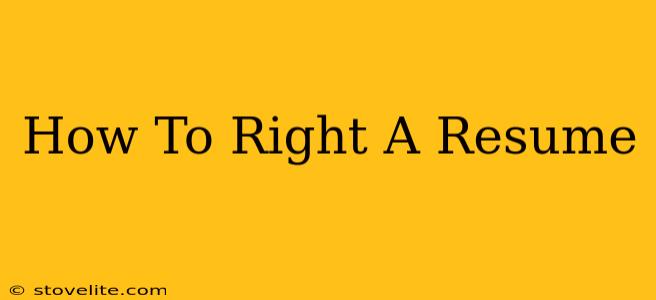Landing your dream job starts with a compelling resume. A well-crafted resume isn't just a list of your work history; it's a targeted marketing document showcasing your skills and experience to potential employers. This guide will walk you through the process of writing a resume that grabs attention and gets you interviews.
Understanding Your Audience: Tailoring Your Resume
Before you even start writing, consider who you're writing for. Each job application requires a slightly customized resume. Analyze the job description carefully. Identify keywords and skills mentioned and weave them naturally into your resume. This shows the hiring manager you understand the role and possess the necessary qualifications.
Key Elements to Customize:
- Keywords: Incorporate relevant industry jargon and keywords directly from the job description.
- Skills Section: Highlight the skills most relevant to the specific job.
- Experience Descriptions: Tailor your accomplishments to match the requirements of the position.
- Summary/Objective: Refine your summary or objective statement to reflect the specific role and company.
Crafting the Perfect Resume Structure
A well-structured resume is easy to read and understand. Here's a recommended format:
1. Contact Information:
- Full Name: Use a professional and easily readable font size (e.g., 16-18pt).
- Phone Number: Include a reliable phone number where you can be easily reached.
- Email Address: Use a professional-sounding email address.
- LinkedIn Profile URL (Optional): Including your LinkedIn profile can provide additional context for recruiters.
- Location (Optional): Consider omitting your full address for privacy reasons. City and state are usually sufficient.
2. Summary/Objective Statement (Optional but Recommended):
This brief section (3-4 sentences) provides a snapshot of your key skills and career goals. A summary statement is best for experienced professionals, highlighting their accomplishments. An objective statement is more suitable for entry-level candidates, outlining their career aspirations.
3. Skills Section:
List both hard skills (technical abilities) and soft skills (interpersonal abilities). Categorize them for clarity. For example:
Hard Skills: Proficiency in Microsoft Office Suite, Data Analysis, Project Management, Programming Languages (Python, Java), etc.
Soft Skills: Communication, Teamwork, Problem-solving, Time Management, Leadership, etc.
4. Work Experience:
This section is crucial. Use the reverse chronological order, starting with your most recent position. For each role, include:
- Job Title:
- Company Name:
- Dates of Employment: (Month/Year – Month/Year)
- Accomplishments: Use the STAR method (Situation, Task, Action, Result) to describe your achievements using quantifiable results whenever possible (e.g., "Increased sales by 15%," "Reduced costs by 10%," "Managed a team of 5"). Focus on your contributions and impact.
5. Education:
List your degrees, certifications, and relevant coursework. Include:
- Degree Name:
- Major/Minor:
- University Name:
- Graduation Date (or Expected Graduation Date):
- GPA (Optional): Include if it's above 3.5.
- Relevant Coursework (Optional): List courses directly related to the job you're applying for.
6. Awards and Recognition (Optional):
Include any relevant awards, scholarships, or recognitions you've received.
Resume Formatting and Design Best Practices:
- Choose a Professional Font: Use a clean and easily readable font like Times New Roman, Arial, or Calibri.
- Use Consistent Formatting: Maintain consistent spacing, font sizes, and bullet points throughout your resume.
- White Space: Leave ample white space to avoid a cluttered look.
- Keep it Concise: Aim for one page, especially if you're early in your career.
- Proofread Carefully: Errors in grammar and spelling can significantly hurt your chances. Have someone else proofread it as well.
Beyond the Resume: Networking and Following Up
Your resume is just the first step. Network with people in your field, attend industry events, and follow up with potential employers after submitting your application. A strong online presence, including a well-maintained LinkedIn profile, can also significantly boost your job search efforts.
By following these steps and tailoring your resume to each job application, you'll significantly increase your chances of landing interviews and securing your dream job. Remember, your resume is your first impression – make it count!

